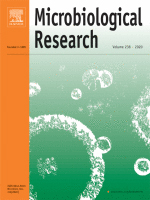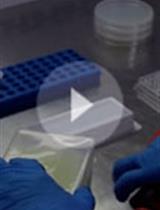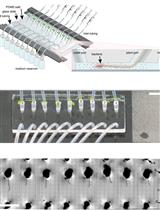- EN - English
- CN - 中文
A Quick Method for Screening Biocontrol Efficacy of Bacterial Isolates against Bacterial Wilt Pathogen Ralstonia solanacearum in Tomato
细菌分离物对番茄青枯病病原菌青枯雷尔氏菌生防效果的快速筛选方法
(*contributed equally to this work) 发布: 2020年11月20日第10卷第22期 DOI: 10.21769/BioProtoc.3829 浏览次数: 5425
评审: Andrea Paola ZuluagaArsheed Hussain SheikhAnonymous reviewer(s)
Abstract
Ralstonia solanacearum is a bacterial phytopathogen able to cause bacterial wilt disease in more than 200 plant species. Plant disease biocontrol strategies are used for controlling this disease and tomato is used as a model plant to conduct R. solanacearum associated studies. Conventional screening methods such as seed bacterization, soil drenching and root bacterization (in grown plants) to assess the ability of biocontrol bacteria to antagonize R. solanacearum under in planta conditions in different hosts are time-consuming and costly. A fast, cost effective method is a key requirement to advance the research on R. solanacearum biocontrol. In this protocol, we have inoculated the roots of tomato seedlings with bacterial isolates showing antagonistic activity against R. solanacearum under in vitro conditions. After 16 h of treatment with the antagonizing bacteria, seedlings were inoculated with R. solanacearum by a well-established root-dip method. Then the seedlings were maintained at controlled conditions and the number of wilted/dead seedlings were recorded up to 10th day post R. solanacearum inoculation. Biocontrol efficacy was calculated from the records for each tested isolate. This protocol is advantageous than already available protocols in the sense that it can be completed within a very short duration (~18 days for tomato) and there is no requirement of culture media to maintain the seedlings. This method can be used for quickly screening large number of bacterial isolates and different host genotypes within a short period of time and at a minimum cost.
Background
Ralstonia solanacearum is a soil-borne bacterial phytopathogen causing bacterial wilt disease in more than 200 crop species representing 50 different families (Seleim et al., 2014), the majority from the family Solanaceae (Thera et al., 2010). It can thrive up to several years in the soil retaining the capability to infect upon arrival of a host (Coutinho and Wingfield, 2017). Its natural route of entry is through the roots and finally, it ends up colonizing in the xylem vessels causing blockage of water conduit due to secreted exopolysaccharides with a corresponding wilting symptom observed in the leaves (Genin and Denny, 2012; Peeters et al., 2013 ; Seleim et al., 2014). Despite having usual practices of disease control such as the use of resistant plant varieties, industrial pesticides (Yuliar et al., 2015), the use of biocontrol agents is a much-preferred choice in the current scenario due to environment friendly nature of the biocontrol agents. Bacteria and bacteriophages have been reported as biocontrol agents against R. solanacearum, of which bacteria being the predominant (Yuliar et al., 2015). The assay for the potential to antagonize R. solanacearum under in vitro conditions is quite easy as standard methods like agar well diffusion (Balouiri et al., 2016), disc diffusion (Gupta et al., 2015) and spot-on lawn assay (Vijayakumar and Muriana, 2015) are available. To be considered as a biocontrol agent of practical use it must primarily have the ability to control the pathogen under in planta condition and it should not have any negative effect on other living beings. The ability of self-sustainability and neutral effect on other living beings is a subject of later consideration, the first and foremost being its ability to antagonize the pathogen under in planta condition (Wang et al., 2019). Conventional methods of bacterial biocontrol agent screening against R. solanacearum under in planta conditions such as seed bacterization (Siddiqui and Meon, 2009) and soil drenching (Van Elsas and Heijnen, 1990) have several limitations as they require viz. 1) large amount of inoculum, 2) prolonged maintenance of plants and 3) large space. In general, these demerits sum up these methods as time consuming and costly. To further advance the research on biocontrol bacteria against R. solanacearum, a quick screening method escaping the limitations of above-mentioned methods is required. Considering the entry of this pathogen through the roots, it was hypothesized that the application of biocontrol bacteria in the root would have the maximum chance to antagonize R. solanacearum thereby attenuating or eliminating its disease-causing capacity. The method described here is easy to perform and economically viable as it requires very less resource and time. The method is useful to screen biocontrol efficacy of several bacterial isolates simultaneously against R. solanacearum in a very limited space.
Materials and Reagents
Micro centrifuge tube 1.5 ml (Tarsons, catalog number: 500010 )
Petri dish 90 mm (Tarson, catalog number: 460050 )
Petri dish 60 mm (Tarson, catalog number: 460061 )
Microtips 200-1,000 μl (Tarson, catalog number: 521020 )
Microtips 2-200 μl (Tarson, catalog number: 521010 )
Microtips 0.2-10 μl (Tarson, catalog number: 521000 )
Absorbent cotton wool (Bengal Surgicals Limited, India/Azpack, catalog number: 12356477 )
Tissue paper roll (Solimo/Kimberly-Clark WypAll L10 Paper Wipes, catalog number: 13478218 )
Polygrid micro tube stand (Tarson, catalog number: 205110 )
Plastic tray (Agrawal Plastic and Packaging Industries)
Cotton plugs (Prepared in laboratory)
Spray bottle (Abdos, catalog number: P11191 )
Inoculating loop (Himedia, catalog number: LA014 )
Hand gloves (Kimtech, catalog number: 97613 )
Spatula (Himedia, catalog number: LA007 )
Parafilm (Himedia, catalog number: LA017 )
HiDispoTM Bag-12 (Himedia, catalog number: PW040 )
Tomato seeds var. Pusa Ruby (JAI Kisan Seeds Private Limited, India)
R. solanacearum antagonizing bacteria (Staphylococcus warneri GL1, Bacillus velezensis GL3, B. velezensis GL5 and B. velezensis GMC2) isolated in authors laboratory from the endosphere of Gnetum gnemon
R. solanacearum F1C1 strain (provided by Prof. S.K. Ray, Tezpur university)
70% ethanol (Himedia, catalog number: MB106-500ML )
1% NaOCl (Himedia, catalog number: AS102-100ML )
Sterile distilled water
Peptone (Himedia, catalog number: RM001-500G )
Acicase (Himedia, catalog number: CR013-500G )
Glucose (Himedia, catalog number: MB037-500G )
Nutrient broth (Himedia, catalog number: M002-500G )
Glycerol (Himedia, catalog number: AS100-500ML )
Agar powder (Himedia, catalog number: CR301-500G )
Casamino acid peptone glucose broth (see Recipes)
Equipment
Beaker (Borosil, catalog number: BRL_1060D21 )
Erlenmeyer flask 250 ml (Borosil, catalog number: 4980021 )
Glass beaker (Borosil, catalog number: 1000D121 )
Forceps (Tarsons, catalog number: 486000 )
Spirit lamp/alcohol burner lamp (Himedia, catalog number: LA275 )
Growth Chamber (Hipoint, model: 740FHLED )
Orbital shaking incubator (Remi, model: CIS-24 plus )
Refrigerated centrifuge (Sigma model: 2-16KL )
Autoclave (Optics, model: 50 litres )
Water purification system (Sartorius, model: Arium mini Plus UV )
Pipettor (Eppendorf Research Plus, catalog numbers: 3120000020 , 3120000046 , 3120000062 )
Weighing balance (Shimadzu, model: BL220H )
Laminar air flow cabin (Cleanair Systems, model: CAH 1200 )
Eppendorf Biophotometer (Eppendorf, model: D30 )
Software
SPSS 20.0
Microsoft Office Excel 2016
Procedure
文章信息
版权信息
© 2020 The Authors; exclusive licensee Bio-protocol LLC.
如何引用
Agarwal, H., Dowarah, B. and Agarwala, N. (2020). A Quick Method for Screening Biocontrol Efficacy of Bacterial Isolates against Bacterial Wilt Pathogen Ralstonia solanacearum in Tomato. Bio-protocol 10(22): e3829. DOI: 10.21769/BioProtoc.3829.
分类
微生物学 > 微生物-宿主相互作用 > 体内实验模型 > 植物
您对这篇实验方法有问题吗?
在此处发布您的问题,我们将邀请本文作者来回答。同时,我们会将您的问题发布到Bio-protocol Exchange,以便寻求社区成员的帮助。
Share
Bluesky
X
Copy link
















